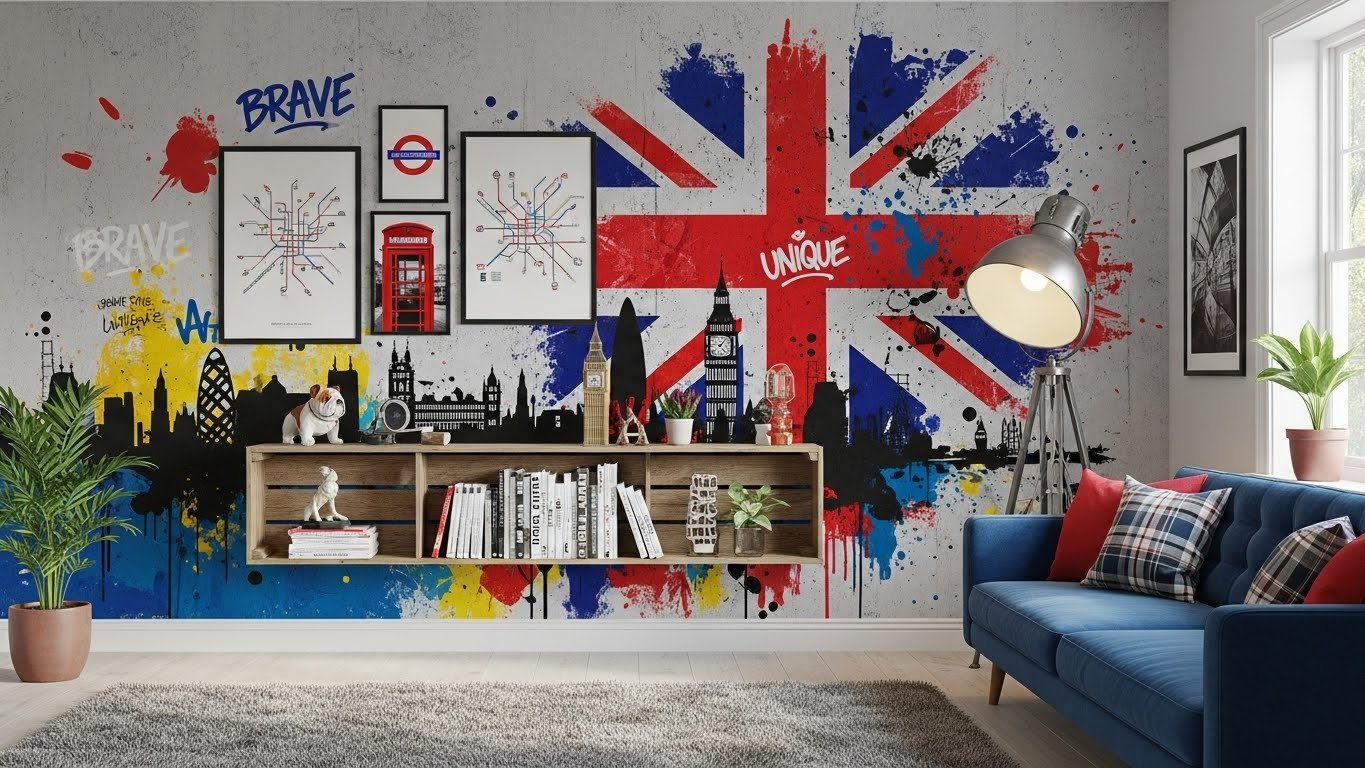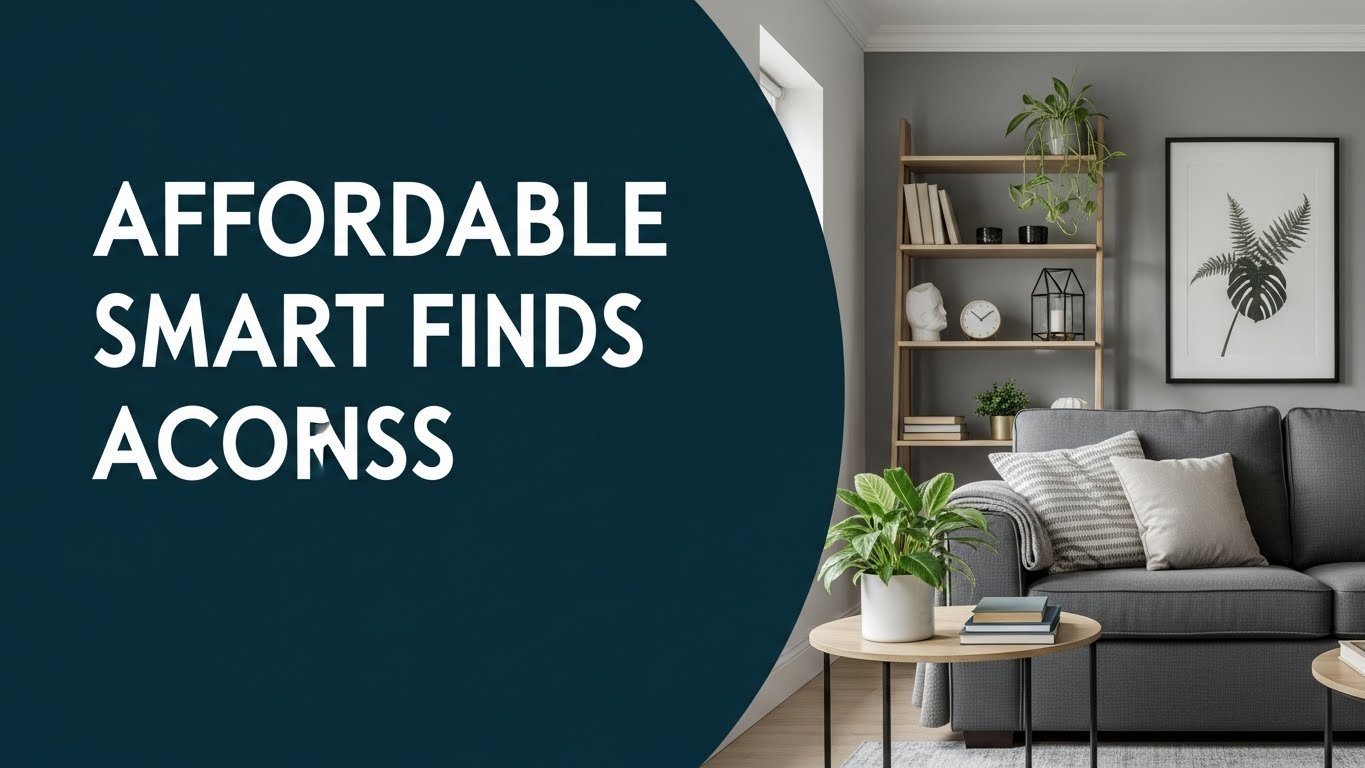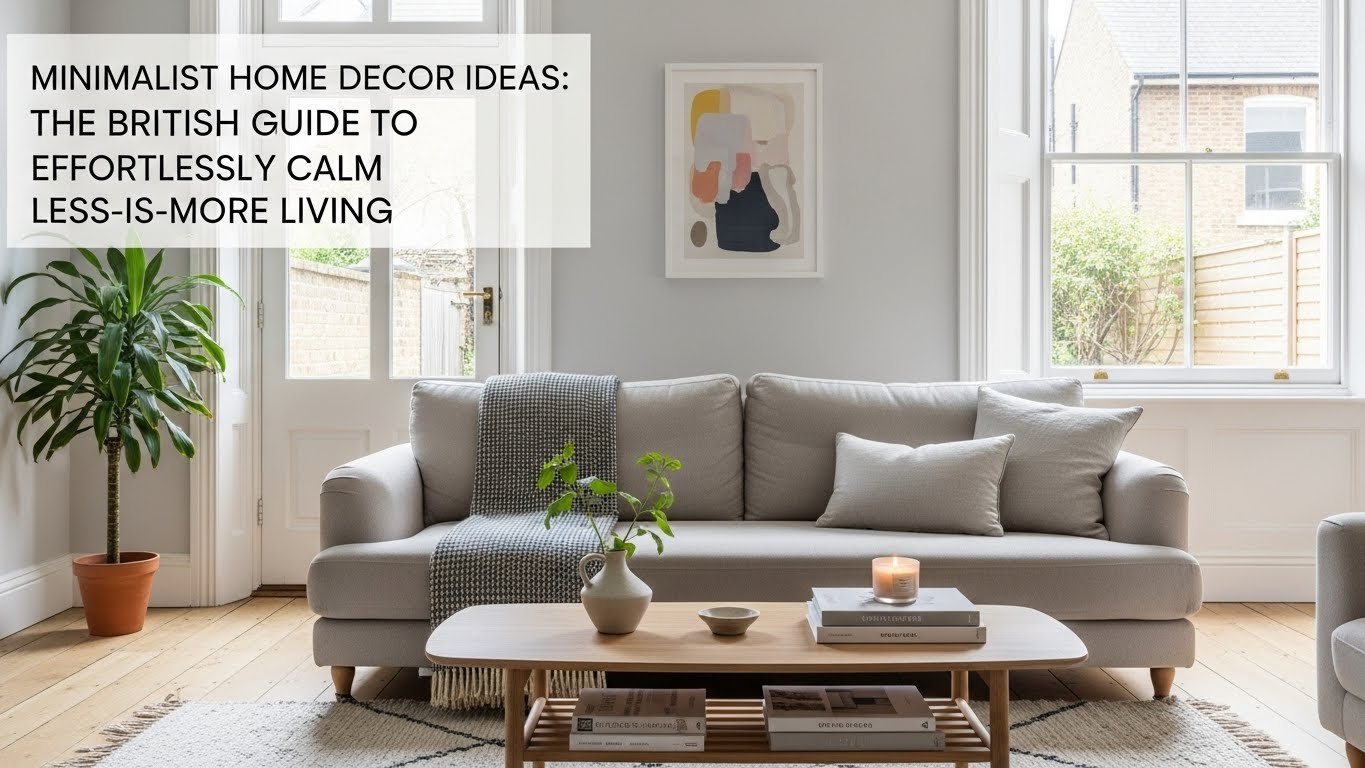Are you dreaming of a peaceful and stylish room in your home? A minimalist living room design could be just what you need. It combines clean lines, simple colours, and tidy spaces to create a calming atmosphere. This is perfect for unwinding.
Minimalist living room designs focus on being both functional and simple. They are great for those who love ease and elegance. In this article, we’ll look at eight different layouts that show off the beauty of minimalist home decor. You’ll see everything from sleek and modern to calm and cosy designs. These will inspire you to refresh your living room design.
The Essence of Minimalist Living Room Design
Minimalist living room design makes your space simpler and more beautiful. It uses clean lines, few decorations, and a simple colour scheme. This creates a calm and welcoming area.
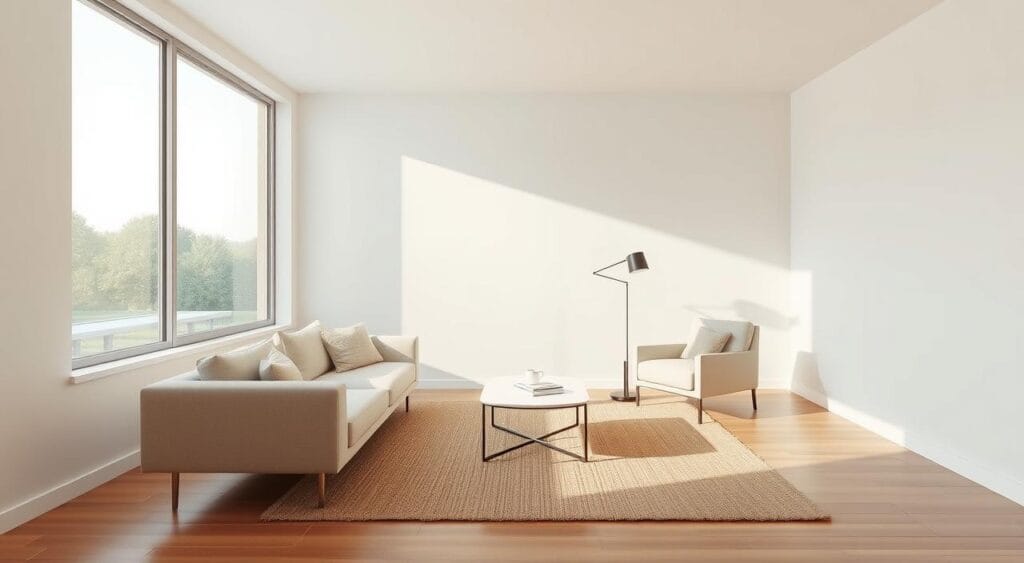
Core Principles of Minimalism
Minimalist design is all about simplicity, function, and being green. Simplicity means using simple shapes and not too much decoration. Functionality means each item has a purpose, cutting down on mess. Sustainability means picking materials that are good for the planet.
Benefits of a Minimalist Living Room
Having a minimalist living room has many advantages. It means less mess, clearer thinking, and a peaceful place. By keeping only what’s needed, you can keep your home tidy. Plus, the calmness of minimalist design can lower stress and bring peace.
Essential Elements for a Successful Minimalist Living Room
To create a minimalist living room, focus on a few key elements. It’s not just about getting rid of clutter. It’s about making a space that looks good and works well. You’ll need to pick the right furniture, choose colours carefully, and use different textures and materials.
Furniture Selection Guidelines
When picking minimalist furniture, remember that less is more. Look for pieces that are useful, simple, and don’t take up too much space. Think about furniture that can do more than one thing, like a storage ottoman or a coffee table with storage. Stay away from big or fancy items that can make the room feel crowded.
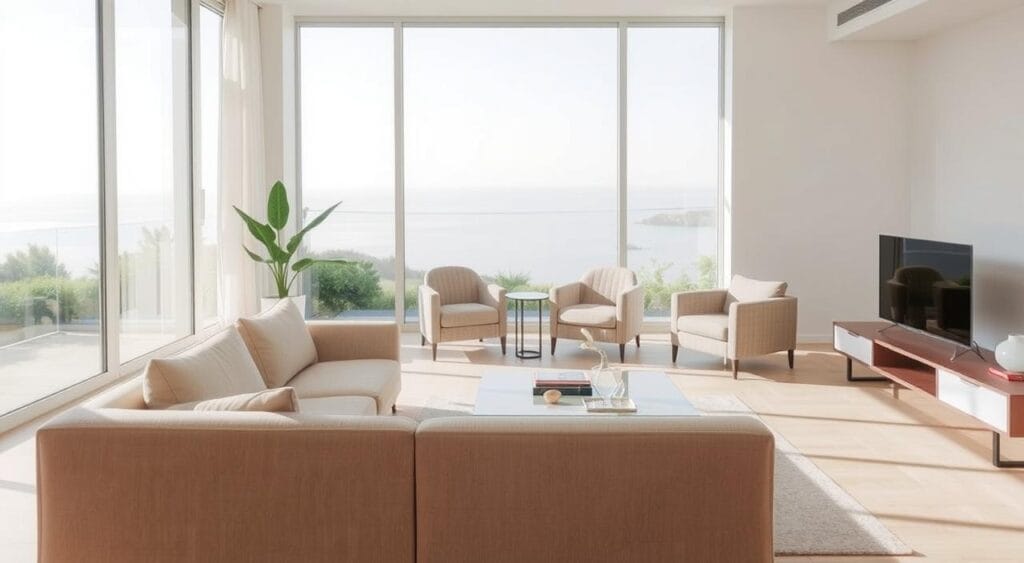
Colour Palette Considerations
Choosing the right colour scheme is key in a minimalist room. Go for colours that are calm, neutral, and the same throughout. White, beige, and grey are good choices because they make the room feel calm and bigger. You can add a bit of colour with accessories, but keep the main colours simple.
Texture and Material Choices
Using different textures and materials can make your minimalist room more interesting. Mix smooth things like glass or metal with natural stuff like wood or woven fibres. This mix creates a nice, layered look that makes the room more beautiful.
Preparing Your Space for a Minimalist Transformation
Before starting a minimalist design, declutter and assess your space. This step is key to a smooth transition to a more streamlined living room.
Decluttering Strategies
Begin by removing items you don’t need from your living room. Sort things into categories: keep, donate, sell, and discard. Be honest with yourself – if you haven’t used it in a year, you probably won’t miss it. Remember, the 80/20 rule suggests you use only 20% of your belongings 80% of the time.
Space Assessment Techniques
After decluttering, assess your space to see its full possibility. Measure your room and note where doors, windows, and architectural features are. This helps you plan a layout that makes the most of natural light and flow.
Planning Your Layout Transition
With a clear view of your space, start planning your minimalist layout. Think about the room’s flow, its function, and the furniture you’ll need. A well-thought-out layout is essential for a successful minimalist makeover.
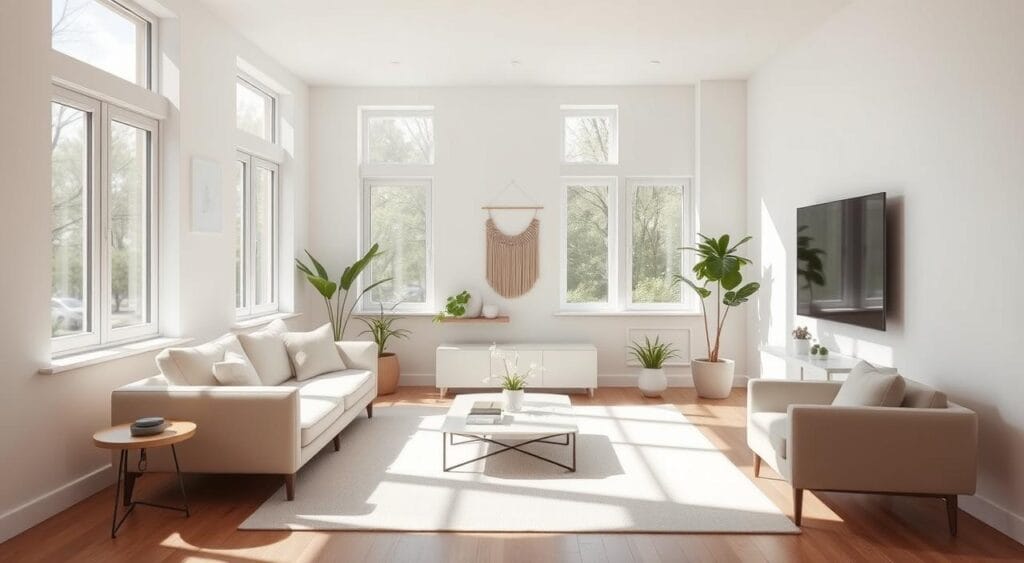
Layout 1: The Symmetrical Balance Design
For a calm and tidy living space, try the symmetrical balance design. It brings peace and order to your room.
Key Features and Benefits
This design mirrors elements on both sides of the room. It’s perfect for those who like things neat and organised.
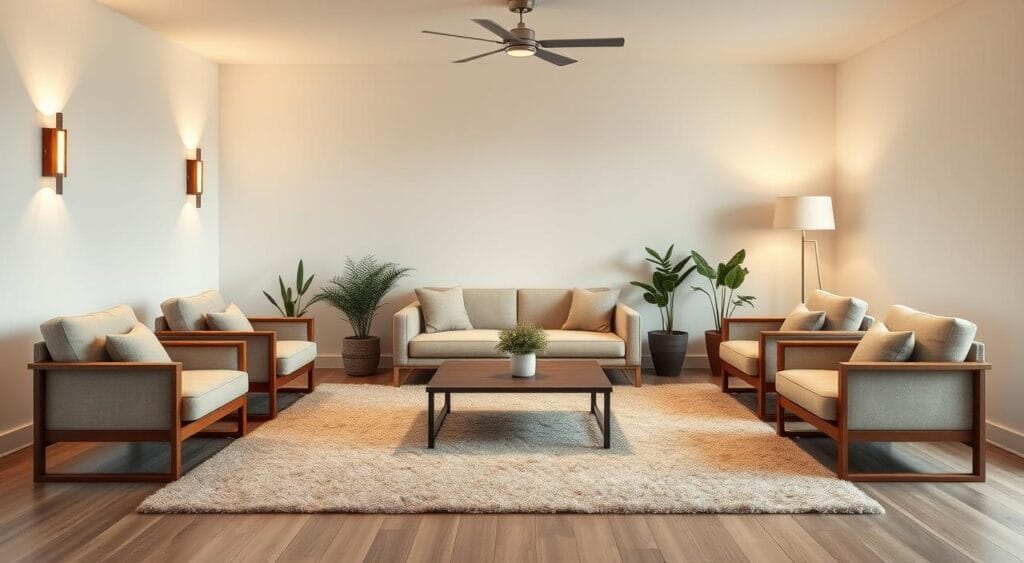
Furniture Arrangement Guide
Begin by placing big furniture, like sofas, in a balanced way. For example, put two armchairs on either side of a coffee table.
Styling Tips for This Layout
To style a symmetrical design, aim for a unified look.
Colour Scheme Recommendations
Stick to a few colours to keep things harmonious. Neutrals like beige, grey, and white work well.
Accessory Selection
Choose accessories that match your colour scheme. Use the same or similar items, like vases or lamps, to keep symmetry. This adds elegance to your room.
Layout 2: The Open-Flow Concept
Adopting the open-flow concept in your living room design can make it feel serene and spacious. This layout aims to create a smooth flow, making your space seem bigger and more connected.
Key Features and Benefits
The open-flow concept is all about simplicity and clear paths. It offers several benefits:
- A sense of spaciousness and freedom
- Enhanced natural light distribution
- Easier navigation and movement within the room
Furniture Arrangement Guide
To get the most out of an open-flow layout, follow these furniture tips:
- Choose multi-functional, minimalist furniture.
- Place furniture to keep paths clear.
- Don’t over-accessorize to avoid clutter.
Styling Tips for This Layout
Styling an open-flow living room is about finding a balance. Here are some tips:
Colour Scheme Recommendations
Stick to a neutral colour palette to enhance openness. White, beige, and soft grays work well.
Accessory Selection
Choose a few statement pieces, like bold art or a sculptural vase. They add interest without cluttering.
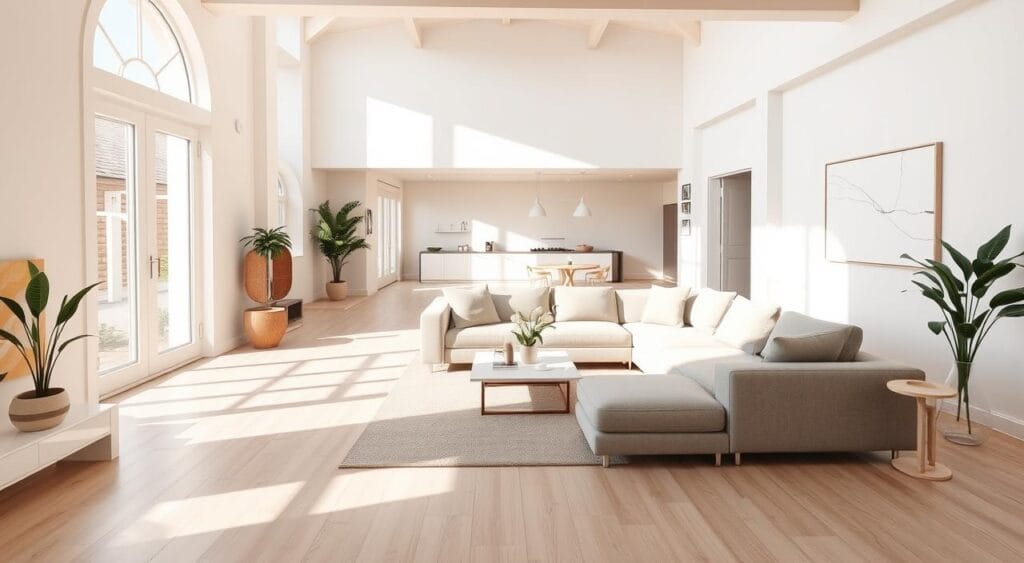
By embracing the open-flow concept and following these guidelines, you can create a living room that feels expansive, serene, and perfectly aligned with minimalist principles.
Layout 3: The Functional Zoning Approach
A well-planned functional zoning approach can turn your living room into a stylish and efficient space. This design strategy divides your living room into different areas or ‘zones.’ Each zone has its own purpose, making the room more functional and attractive.
Key Features and Benefits
The functional zoning approach has many benefits. It improves organization and makes your living room more streamlined. By setting up separate zones for different activities, you can cut down on clutter. This makes your living room more comfortable and welcoming.
- Efficient Use of Space: Functional zoning maximizes your living room’s layout.
- Enhanced Organization: Designating specific areas for activities keeps your living room tidy.
- Improved Aesthetic Appeal: A well-planned functional zoning approach boosts your living room’s look.
Furniture Arrangement Guide
To effectively use functional zoning, arrange your furniture to clearly define each zone. Think about the flow of traffic in your living room. Place furniture to create natural paths.
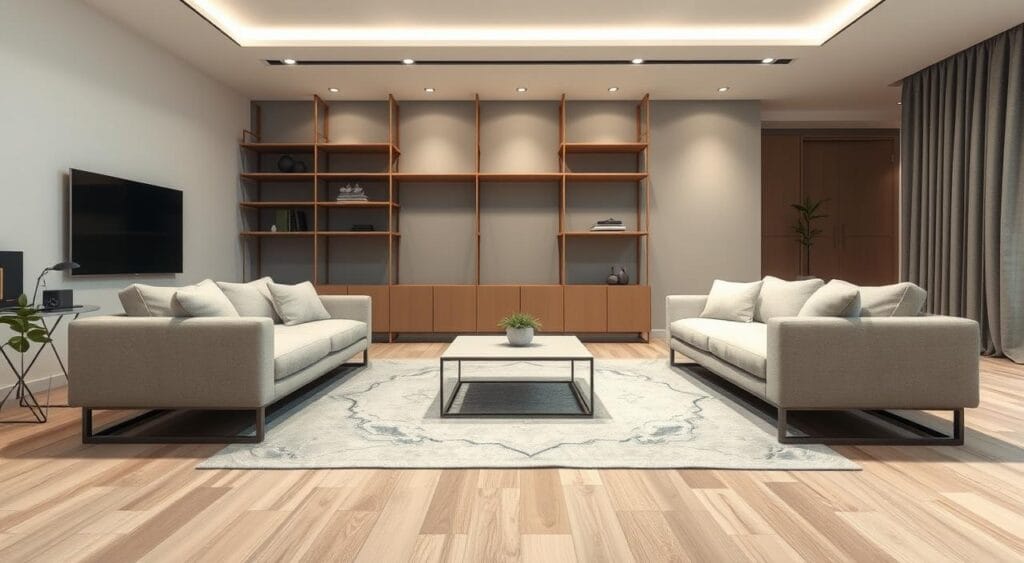
Styling Tips for This Layout
When styling your functionally zoned living room, keep these tips in mind:
Colour Scheme Recommendations
Choose colours that match each zone’s function. For example, a reading nook might have calming colours. An entertainment zone could have brighter tones.
Accessory Selection
Pick accessories that are both useful and look good. For example, a storage ottoman can be a seat and a storage unit.
By following these strategies, you can make a living room that’s both beautiful and practical.
Layout 4: The Compact Living Room Solution
In smaller living rooms, a minimalist approach can make the space feel larger and more welcoming. This layout focuses on compact living room solutions that are both functional and stylish.
Key Features and Benefits
The compact living room solution is designed to maximise space while maintaining a minimalist aesthetic. Key benefits include:
- Optimised furniture selection
- Efficient use of space
- A clutter-free environment
Furniture Arrangement Guide
To create an effective compact living room, consider the following furniture arrangement tips:
- Select multi-functional furniture pieces.
- Use wall-mounted shelves and units.
- Opt for a minimalist sofa design.
Styling Tips for This Layout
Styling a compact living room requires careful consideration of space-saving techniques and visual expansion tricks.
Space-Saving Techniques
Utilise furniture with storage, such as ottomans or storage coffee tables, to keep clutter at bay.
Visual Expansion Tricks
Use light colours on walls and floors to create a sense of openness. Also, strategically placing mirrors can enhance the feeling of space.
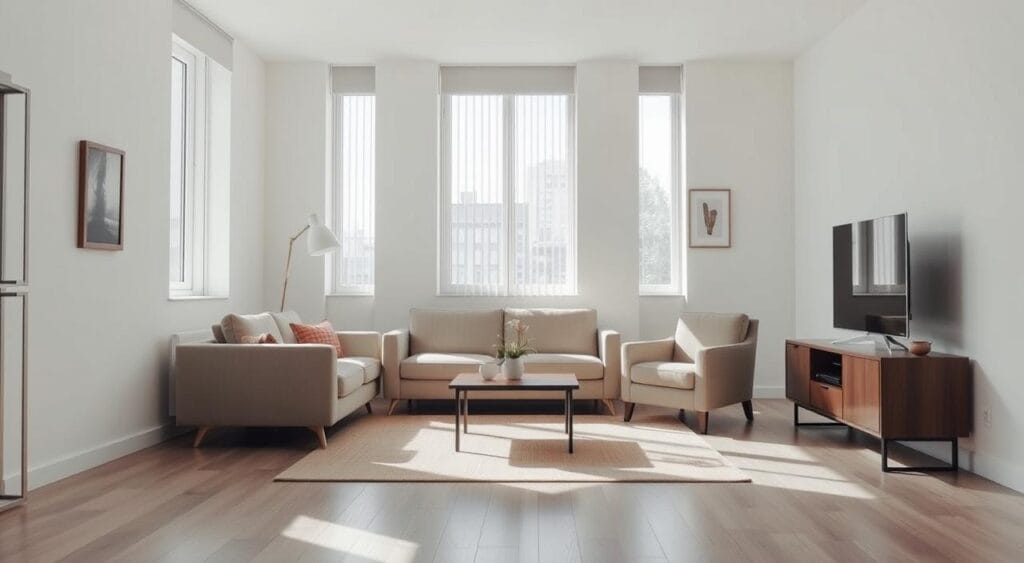
By implementing these strategies, you can create a minimalist compact living room that feels spacious and inviting.
Layout 5: The Conversation-Focused Living Room
Designing a living room for conversation is key. It’s perfect for those who love to chat and want a cozy living room. This space is all about making connections.
Key Features and Benefits
A conversation-focused living room is all about comfort and talking. The main perks are:
- More socialising
- Better chats with family and friends
- A place where everyone feels welcome
Furniture Arrangement Guide
For a layout that encourages talking, follow these tips:
- Set up seats in a circle or U shape for better chats.
- Use a coffee table or ottoman as a meeting spot.
- Don’t put furniture too far apart or too close to walls.
Styling Tips for This Layout
To make your living room even cozier and more visually appealing, add:
- Warm lighting for a welcoming feel
- Soft textiles like throw blankets and pillows
- Art or decor that starts interesting talks
Seating Arrangement Strategies
Choosing the right seats is vital in a conversation-focused room. Think about sectional sofas or circular seating to bring people together.
Creating Intimate Zones
To make your living room feel more personal, use area rugs, lights, and furniture. This creates cozy spots and encourages talking.
Layout 6: The Multi-Functional Living Room
You can turn your living room into a space that does many things. It can be for relaxing, watching TV, working, or studying. This is great for homes with little space.
Key Features and Benefits
A multi-functional living room has lots of benefits. It makes the most of the space and is very flexible. You can change it to fit different needs and activities.
Key benefits include:
- Maximised space utility
- Flexibility in room usage
- Enhanced functionality
Furniture Arrangement Guide
Arranging furniture well is key for a multi-functional living room. Choose furniture that can do more than one thing.
For instance, a storage ottoman can be a seat and a place to store things. A desk with a foldable top is great for work or study and can be put away when not needed.
Styling Tips for This Layout
Styling a multi-functional living room needs careful thought. Use a colour scheme that works well together. Choose furniture with simple designs to keep things harmonious.
Versatile Furniture Selection
Picking the right furniture is vital. Go for pieces that can be used in different ways. A sofa bed or a coffee table with storage are good examples.
Transitional Space Design
Designing transitional spaces in your living room helps create areas for different activities. Use rugs, lights, and furniture to make clear zones in the room.
Layout 7: The Statement Piece Centred Design
Adding a statement piece to your living room can make it more interesting. This design focuses on a bold, eye-catching item as the main attraction. The rest of your decor then balances around it.
Key Features and Benefits
This design has many advantages. It creates a striking focal point and brings personality to your space. The main elements are a bold statement piece, balanced decor, and a simple background to keep things tidy.
Furniture Arrangement Guide
To centre your design, place the statement piece in a key spot. Then, arrange your furniture to draw attention to it. Make sure your furniture’s size and shape match the statement piece for Visual Balance.
Styling Tips for This Layout
Keep the decor around your statement piece simple and uncluttered. Use a few colours that match the piece and add textures and materials for depth. This way, you avoid overwhelming the space.
Selecting the Right Statement Piece
Picking the right statement piece is key. Choose something that shows your style and fits your living room’s look. It could be a bold art piece, a unique furniture item, or a striking light fixture.
Balancing Visual Weight
To get Visual Balance, make sure the statement piece is balanced by the decor around it. Use colours, textures, and shapes to create harmony.
By picking the right statement piece and balancing it with simple decor, you can make a stylish and calm living room.
Layout 8: The Nature-Inspired Minimalist Living Room
You can make your living room calm and welcoming by using nature-inspired minimalist design. This style brings the outdoors inside. It uses natural elements and eco-friendly materials for a peaceful and green decor.
Key Features and Benefits
A nature-inspired minimalist living room is simple and uses natural materials. It has a calming colour scheme. This design reduces environmental harm, brings calm, and offers a unique look that connects you with nature.
Furniture Arrangement Guide
Think about how natural light flows when arranging furniture. Place furniture to keep the space open. This lets light and views move freely.
Styling Tips for This Layout
To style your room, focus on natural textures and materials like wood, stone, and plants. Use a neutral colour scheme with green accents to enhance the natural vibe.
Incorporating Natural Elements
Adding natural elements like branches, rocks, or shells can make your space interesting. Use a vase with branches or a bowl with river rocks as a decorative item.
Sustainable Material Choices
Choose furniture and decor made from sustainable materials. Look for items that are recycled, recyclable, or made sustainably. This choice is good for the planet and adds authenticity to your design.
Adapting Minimalist Layouts to Different Living Room Shapes
Creating a minimalist living room starts with understanding the room’s shape and size. Whether it’s long and narrow or open-plan, there are ways to make the most of it. These strategies help enhance the room’s natural beauty.
Solutions for Long, Narrow Living Rooms
In long, narrow rooms, dividing the space into zones can make it feel more balanced. A console table or a room divider can help separate areas.
- Use furniture to create a sense of width
- Opt for a minimalist rug to define the seating area
- Keep the colour palette light and airy
Strategies for Open-Plan Spaces
Open-plan living rooms need careful planning to stay minimalist. Use area rugs and strategic lighting to create different zones.
Approaches for Small or Awkward Living Rooms
In small or awkward rooms, choose furniture that fits well. Look for multi-functional pieces, like a storage ottoman, to save space.
By using these strategies, you can make a minimalist living room that looks and functions well. It doesn’t matter what shape or size the room is.
Maintaining Your Minimalist Living Room Over Time
Keeping your minimalist living room looking great isn’t just about the design. It’s also about the care you give it every day. To keep your space calm and clutter-free, you need to have routines and strategies. These will help keep your room tidy and fresh.
Daily and Weekly Maintenance Routines
Begin with simple daily habits. Put things away after you use them. Spend a few minutes each day tidying up. Then, set aside time each week to dust, vacuum, and make sure everything is where it should be. This Minimalist Maintenance stops clutter from piling up.
Seasonal Refresh Strategies
Seasonal changes can make your minimalist living room feel new. Try swapping out textiles, moving furniture, or adding new decor. It’s also a chance to check if your belongings fit your minimalist style.
Preventing Clutter Accumulation
To keep your space tidy, stop clutter from building up. Use Clutter Prevention methods like regular decluttering and think carefully about new items. This way, you’ll keep your living room calm and organized, following the Home Care principles.
Conclusion
You now have the tools to make your living room calm and useful. By following minimalist design, you can have a tidy space that’s great for relaxing and chatting. The eight layouts we talked about are a good start for a lovely and useful living room.
When you start your design, pick furniture that looks good and works well. Adding natural textures and materials can make your space richer. Your Living Room Design should show off your style but stay true to minimalism.
Keeping your Minimalist Living Room tidy is key. Regular cleaning and choosing decorations carefully will keep it calm. By using these Home Decor tips, you’ll have a peaceful and welcoming living area that you’ll enjoy.

